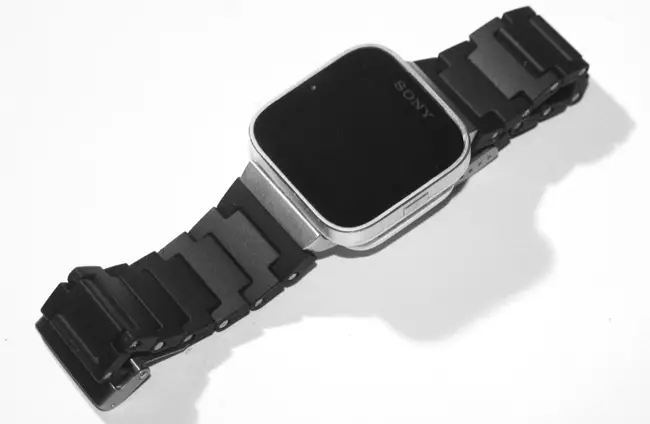Sony Smartwatch MN2 review
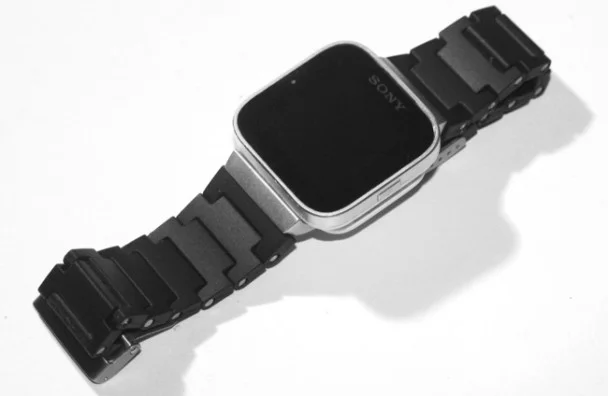
I’ve had my Sony Smartwatch MN2 for a couple of months now, and posted several articles about it or that mention it. Now that I feel that I know the device well, however, it’s time for a full review.

In the box
The Sony Smartwatch comes with little more than the bare essentials. You get the watch, a rubber wrist band, charging cable, and a metal piece that can be attached to 20mm watch straps to allow the smartwatch to be used with those. Both the rubber wrist straps and the charging cable can also be bought as accessories, which is a necessity since the charging cable is proprietary.
Furthermore, the straps are available in a variety of colors if bought separately, though at that point you might want to just get an actual watch strap and use the adapter, like you see in the picture at the top. The rubber strap that comes with it is the one pictured on the right.
Design
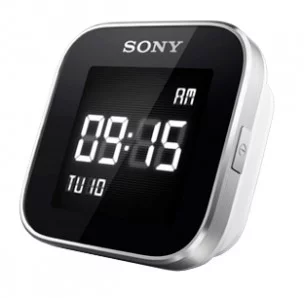 The Sony Smartwatch is essentially a small screen with a clip on it. The hard plastic touchscreen is surrounded by a black bezel, the bottom is white, and the sides are aluminum. The white plastic on the bottom frankly makes the watch look much cheaper than it has to, especially when used with a decent watch strap, and a much better choice would have been aluminum for that part of it as well.
The Sony Smartwatch is essentially a small screen with a clip on it. The hard plastic touchscreen is surrounded by a black bezel, the bottom is white, and the sides are aluminum. The white plastic on the bottom frankly makes the watch look much cheaper than it has to, especially when used with a decent watch strap, and a much better choice would have been aluminum for that part of it as well.
The back of the watch has a non-removable clip that is also the way you both attach it to a strap, and attach the charge cable. In what I can only assume is related to making it splash proof, Sony ditched the microUSB port from the old LiveView, opting for a proprietary system that has to have been designed by a moron. The underside of the watch has an indentation with some pins on it, and the cable is designed almost like a gripping hand that snaps into that indentation, relying on the clip to hold its metal connection points securely to the pins on the watch. This makes for a very bad connection that often won’t initiate or just loses the connection if a fly happens to fart nearby, and it’s a common issue with this watch. I’ve woken up to a watch with less battery power than when I set it to charge, because the cable has lost connection to the watch during the night.
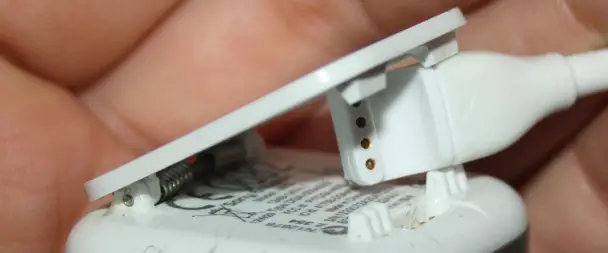
Finally you have the watch’s only actual button, located on the right side. This is the power/wake button, and is neatly tucked into the aluminum ribbon along the side. It can be a bit hard to hit, which is only a problem since the tap-to-wake feature has a tendency to stop working- but more on that later.
Basic operation
The watch connects to the phone via Bluetooth, which makes it vulnerable to the same issues that any smartwatch on Android faces: fragmentation. Different devices have different Bluetooth stacks (the driver that controls Bluetooth), with some stacks being completely useless for smartwatches. When I ran stock Gingerbread on my Galaxy S II, I got to experience first hand how useless some Bluetooth stacks can be, and it was only after moving to a custom ROM that I could even use a smartwatch. Point being, don’t assume that this watch will work well with your device, especially if it’s a Samsung device running a stock ROM.
Anyways, the watch requires a few apps to even connect. Once installed, the pairing process is fairly simple, and after that it should reconnect automatically. I say “should” because I’ve had varying results when doing things like rebooting the phone, where sometimes the watch has failed to reconnect until I’ve rebooted again. It seems to be related to the background process that controls the watch needing to start properly before a Bluetooth connection is made, and ever since I started turning off the watch until the phone was properly rebooted, it’s not been a major issue.
Software
 With the watch paired and set up, you can start downloading plug-ins for it from Google Play. Some are official Sony ones, some are third party. Some free, some not. You install them like normal apps, and then they’re available as options in the control app for the watch. Each plug-in has two basic ways it can show up on the watch: as a widget, and as an application. The main menu of the watch has one row for widgets on top, and one row for application icons on the bottom, where you swipe up and down to switch between them. The actual watch is sort of like the screen saver, accessible by clicking the power button from elsewhere in the system. It can also be customized to some extent with different watch faces.
With the watch paired and set up, you can start downloading plug-ins for it from Google Play. Some are official Sony ones, some are third party. Some free, some not. You install them like normal apps, and then they’re available as options in the control app for the watch. Each plug-in has two basic ways it can show up on the watch: as a widget, and as an application. The main menu of the watch has one row for widgets on top, and one row for application icons on the bottom, where you swipe up and down to switch between them. The actual watch is sort of like the screen saver, accessible by clicking the power button from elsewhere in the system. It can also be customized to some extent with different watch faces.
If a plug-in is enabled as a widget, it will show up in the row of widgets, and regardless of that it will also show up on the bottom as an application icon. Widgets are just single screens of information, while applications can be more complex, just like on an actual phone. You can also control notification settings for each plug-in, deciding which plug-ins can make the phone vibrate and show notifications.
As for what sort of plug-ins you can get, it varies. Most of them have to do with notifications, for everything from email, to SMS, to calls, to just apps that forward any notification. You do however have other plug-ins as well, like games, music remotes, and so on. If it makes sense to put on a watch, there’s likely a plug-in for it.

Personally, I bought the watch solely because of the existence of one specific plug-in: AppWidgetDisplay. It allows you to place phone widgets on your watch, and while it’s essentially been abandon and doesn’t work with all widgets, it’s still the only reason why I have this watch. It has allowed me to create custom widgets to control Tasker, which combined with the ability to receive tailored notifications (read more about both these things in this post) basically means I have the ability to set up two way communication of anything I want. I use it to control the lights in my apartment, remotely activate timers, receive custom notifications for all sorts of Tasker things, and so on.
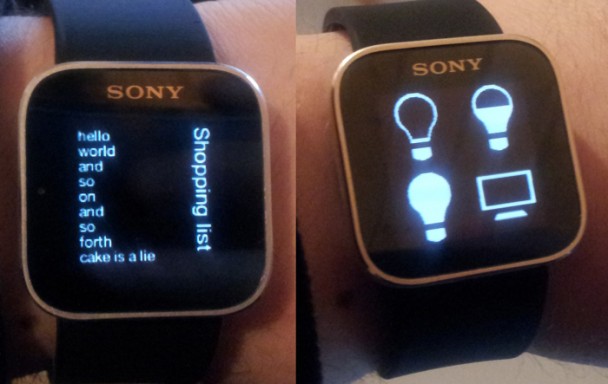
In use
The Sony Smartwatch isn’t exactly the most popular accessory out there, which is because it has as many flaws as it has advantages. One of them is that while you’re supposed to be able to turn on the screen to check the time by tapping the watch twice, that only really works if the watch was showing the watch face when it turned off the screen. Speaking of turning off the screen, there’s no way to do that, and you have to wait for the screen timeout to make the watch go away. That can be quite annoying in dark places, and since you can neither adjust the screen brightness nor the screen timeout, you just have to get used to it. That also causes problems in another way, in that the screen is practically unreadable outdoors.
To continue the list of issues, the touch screen isn’t very responsive at times. There are times I’ve wanted to smash the watch into tiny little pieces from trying to get the screen to respond, and despite the fact that the touchscreen is what allows the widget app to even be possible, I have to say that buttons are the way to go for smartwatches in general.
Despite those and the previously mentioned issues however, I quite like the watch, and I’m glad I bough it. Having notifications pop up on my wrist is quite useful, and becomes even more useful when I can tap into that with Tasker to customize it however I want. The same goes for widgets through AppWigetDisplay, and frankly this watch is ten times more useful for a heavy Tasker user than it is for anyone else. Tasker compatibility is also the main reason to pick something like this over the Pebble at this point, as the Pebble is only very slowly gaining Tasker support, and it has nothing that comes close to what you can do with AppWidgetDisplay and custom widget creation apps.
As for wearing the watch, it’s small enough that I don’t really notice it, which is a good thing. I did end up getting a different watch strap for it (the one shown in the image on top) and using the adapter that comes with the watch, as even though the rubber strap that comes with the watch isn’t bad, my skin didn’t much care for it. It’s nice that Sony included that part, and I just wish the white plastic bottom wasn’t there to make the watch look like a toy no matter what you attach it to.
I’ve been especially surprised by the battery life. Being a tiny device with a color LCD screen, I was expecting to have to charge the watch every night, but in reality I’ve been able to go 3-4 days on a charge with my level of use. That means it’s much less of an inconvenience to have to deal with the horrible charging cable.
Conclusion
The Sony Smartwatch MN2 has a lot of flaws, ranging from minor inconveniences to design decisions that make you wonder about the intelligence of the people who made them. At $125 in the US (Amazon) it’s a lot more expensive relative to the Pebble and Meta Watch than what it is here in Norway (where the Sony watch is 1/3 the price of the other two), and given that, I’m not sure if I can actually recommend this to anyone. I think it comes down to Tasker integration: this watch is awesome if the idea of making your own Tasker control widgets for a watch sounds as awesome to you as it did to me, but if it doesn’t, I’d look at one of the other watches on the market.

